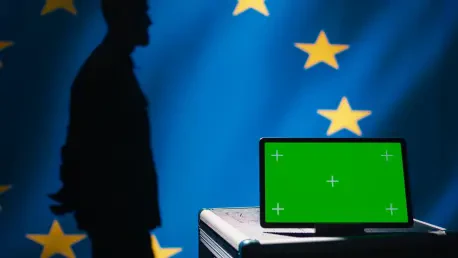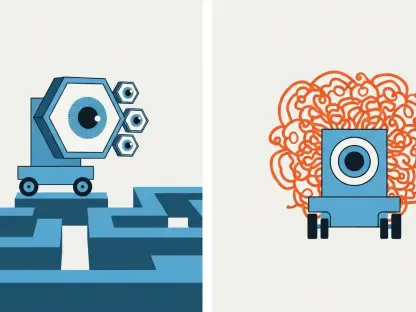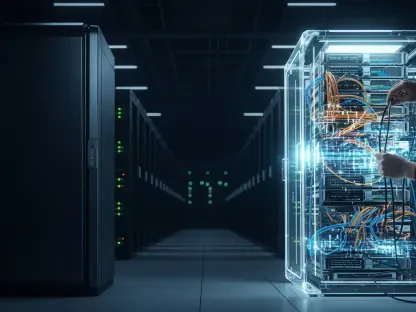The European Union’s ambitious AI Act, designed to regulate the rapidly evolving landscape of artificial intelligence (AI), has ignited a firestorm of criticism among the continent’s creative communities, with many feeling their livelihoods and cultural contributions are at stake. On July 30 of this year, a formidable coalition of 39 organizations, representing millions of creators from sectors as diverse as music, film, publishing, and journalism, released a scathing joint statement condemning the implementation measures of this landmark legislation. Spearheaded by the European Publishers Council, the group contends that the Act, particularly in its handling of generative AI (GenAI), fails to safeguard intellectual property (IP) rights. This growing dissent raises critical questions about balancing technological innovation with the protection of Europe’s cultural backbone. As the debate unfolds, the stakes are not merely economic but deeply tied to the identity and diversity of the region’s creative output. The concerns center on specific components like the General-Purpose AI (GPAI) Code of Practice and training data disclosure templates under Article 53, which creators argue prioritize tech giants over artists. With enforcement timelines stretching to 2026 and 2027, the urgency to address these grievances is palpable, setting the stage for a pivotal clash between policy, innovation, and heritage.
Unpacking the Core Issues for Creators
Intellectual Property at Risk
The crux of the dissatisfaction among European creators lies in the perceived inadequacy of protections for intellectual property rights under the EU AI Act. Article 53 of the legislation includes provisions intended to empower rightsholders to defend their work under EU law, yet the coalition argues that the practical tools—such as the GPAI Code of Practice—lack the necessary strength to curb violations. GenAI providers are accused of exploiting copyrighted material to train their models without permission or compensation, a practice that undermines the very foundation of creative industries. This issue is not merely theoretical; it represents a daily erosion of value for artists, writers, and musicians who see their work repurposed into commercial AI tools without consent. The coalition’s frustration is compounded by the belief that the current framework seems to tilt the playing field in favor of technology companies, allowing them to profit from infringements while creators bear the loss.
Further deepening the concern is the lack of effective mechanisms to hold GenAI providers accountable. The training data disclosure template under Article 53, meant to shed light on the materials used to develop these models, is widely criticized as insufficient. Creators argue that without clear, enforceable transparency, they are left in the dark about how their works are being utilized, making it nearly impossible to seek redress. This opacity not only hampers individual creators but also sets a dangerous precedent for the future of IP rights in the digital age. As GenAI technologies become more pervasive across European markets, the coalition warns that the absence of robust safeguards could lead to a systemic devaluation of original content, threatening the sustainability of creative professions.
Economic and Cultural Stakes
Beyond the legal intricacies of IP, the economic and cultural implications of the AI Act’s implementation are staggering for Europe’s creative sectors. These industries contribute nearly 7% to the EU’s GDP and employ around 17 million individuals, surpassing the economic impact of sectors like pharmaceuticals and automobiles combined. Despite this immense value, the coalition feels their voices were sidelined during extensive consultations involving nearly 1,000 stakeholders from September last year to July of this year. The fear is that unchecked GenAI deployment will erode market share for traditional content creators, as AI-generated outputs—often built on scraped, unlicensed data—flood the market with cheaper alternatives. This competitive disadvantage poses a direct threat to the livelihoods of millions who depend on creative work for income.
Equally concerning is the potential impact on Europe’s cultural heritage, which is a defining element of the region’s global identity. The coalition argues that the current measures risk diluting the diversity and richness of artistic expression by allowing GenAI models to replicate and replace human-created works without proper attribution or compensation. Such a trend could undermine the cultural fabric of the EU, diminishing the unique contributions of its musicians, filmmakers, and authors. The broader worry is that this imbalance could destabilize the EU Single Market, as the economic foundations of creative industries weaken under the pressure of unfair competition. The call for revised policies is thus not just about economics but about preserving a legacy that shapes societal values across the continent.
A United Front Across Creative Sectors
Diversity in the Coalition’s Makeup
The opposition to the EU AI Act’s implementation measures is remarkable for its breadth, uniting a diverse array of creative fields under a single banner of discontent. The coalition of 39 organizations spans music, film, television, journalism, photography, publishing, and academic content, representing the interests of millions of creators. Groups such as CISAC, which advocates for over 5 million creators worldwide, and GESAC, supporting more than 1.2 million authors in Europe, have joined forces to voice their shared grievances. While the specific challenges faced by each sector differ—publishers grapple with the unauthorized use of written works, while audiovisual creators worry about scraped footage—their collective stance sends a powerful message. This unity underscores the scale of the perceived threat posed by the current regulatory framework.
The diversity within the coalition also highlights the universal nature of the concerns surrounding GenAI technologies. For instance, musicians fear the replication of their compositions in AI-generated tracks, while photographers and visual artists are alarmed by the use of their images in training datasets without consent. Despite these varied focuses, the underlying issue remains consistent: the AI Act’s measures fail to provide adequate protection against exploitation. This broad-based alliance amplifies the urgency of their demand for the European Commission to revisit the implementation package, ensuring that the rights of all creative professionals—regardless of their medium—are safeguarded. The strength of this collective voice suggests that ignoring their pleas could have far-reaching political and cultural repercussions.
Shared Frustrations Despite Varied Needs
While the coalition is diverse, the shared frustration with the EU AI Act unites them in a way that transcends individual sector concerns. Each group, from filmmakers to academic publishers, perceives the current framework as a missed opportunity to strike a fair balance between technological advancement and creator rights. The consensus is that the implementation tools, particularly around transparency and enforcement, do not live up to the Act’s original promise of protecting IP. This collective disappointment is rooted in the belief that their extensive engagement in the consultation process was ultimately disregarded, leaving them vulnerable to the rapid deployment of GenAI models across European markets.
Moreover, the coalition’s unified opposition reflects a deeper anxiety about the future of creative industries in an AI-dominated landscape. The fear is that without immediate action, the economic and cultural damage caused by unfair competition will become irreversible. For example, news media organizations worry about the impact on journalism’s integrity, while music bodies are concerned about the loss of royalty streams. Yet, across these differences, the call for stronger, more enforceable protections remains the same. The coalition’s ability to present a cohesive front, despite the complexity of their individual needs, places significant pressure on policymakers to address these shortcomings before enforcement deadlines in the coming years. This solidarity is a testament to the gravity of the issue at hand.
Navigating Tech Responses and Regulatory Hurdles
Tech Industry’s Divergent Approaches
The response from the technology sector to the EU AI Act adds a layer of complexity to an already contentious debate. Some prominent companies, such as Microsoft and OpenAI, have indicated a willingness to engage with the voluntary GPAI Code of Practice, signaling at least a partial commitment to aligning with regulatory expectations. However, others, like Meta, have outright rejected participation, citing legal uncertainties and potential conflicts with existing frameworks. This divergence among tech giants illustrates the challenge of crafting a regulatory environment that can accommodate the interests of both creators and innovators. The lack of uniformity in the tech industry’s approach raises questions about the feasibility of voluntary compliance as a mechanism for ensuring accountability.
Additionally, the split in tech responses underscores the broader tension between fostering AI innovation and protecting traditional industries. For companies that resist the Code of Practice, the argument often centers on the need for flexibility to develop cutting-edge technologies without overly restrictive oversight. Yet, from the creators’ perspective, this reluctance is seen as a refusal to take responsibility for the use of copyrighted materials in AI training. The resulting impasse suggests that the European Commission faces an uphill battle in reconciling these opposing viewpoints. As enforcement deadlines loom in 2026 and 2027, the varied stances within the tech sector could either hinder or catalyze progress toward a more balanced regulatory solution, depending on how policymakers navigate these differences.
Policy Challenges and Future Implications
Crafting effective policy for AI regulation in the EU is proving to be a formidable task, given the stark divide between creative industries and technology firms. The current implementation measures, including the GPAI Guidelines finalized earlier this year, are viewed by creators as inadequate for addressing the unlicensed use of protected content. The coalition’s demand for a revised framework places significant pressure on the European Commission to revisit its approach, particularly in enforcing transparency and IP protections under Article 53. Failure to bridge this gap risks alienating a vital economic sector while potentially stifling cultural output, a consequence that could resonate across the EU’s social and political landscape.
Looking ahead, the implications of this debate extend far beyond immediate regulatory adjustments. The ongoing friction highlights a fundamental challenge in EU policymaking: ensuring that technological progress does not come at the expense of cultural and economic equity. The varied responses from tech companies further complicate the path forward, suggesting that future negotiations will require nuanced compromises to satisfy all stakeholders. As the deadlines for compliance draw closer over the next few years, there is an urgent need for dialogue that prioritizes actionable solutions. The European Parliament and Member States are now urged to scrutinize the implementation process, ensuring that the concerns of creators are not just heard but actively addressed in shaping the future of AI governance.









